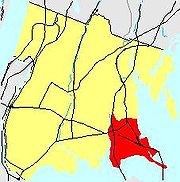 Throggs Neck (also known by its alternate spelling, Throgs Neck) is a narrow spit of land in the southeastern portion of the borough of the Bronx in New York City. It demarcates the passage between the East River and Long Island Sound. “Throggs Neck” is also the name of the neighborhood of the peninsula, bounded on the north by East Tremont Avenue and Baisley Avenue, on the west by Westchester Creek, and on the other sides by the above-named bodies of water. Throggs Neck was largely exempt from the severe urban decay that affected much of the Bronx Borough and boasts a diverse housing stock including middle and upper middle class neighborhoods.
Throggs Neck (also known by its alternate spelling, Throgs Neck) is a narrow spit of land in the southeastern portion of the borough of the Bronx in New York City. It demarcates the passage between the East River and Long Island Sound. “Throggs Neck” is also the name of the neighborhood of the peninsula, bounded on the north by East Tremont Avenue and Baisley Avenue, on the west by Westchester Creek, and on the other sides by the above-named bodies of water. Throggs Neck was largely exempt from the severe urban decay that affected much of the Bronx Borough and boasts a diverse housing stock including middle and upper middle class neighborhoods.
Throggs Neck is at the northern approach to the Throgs Neck Bridge, which connects the Bronx with the borough of Queens on Long Island in the neighborhood of Bayside. The Throgs Neck Lighthouse stands at its southern tip. Historically, the correct spelling is with two “g’s,” and while NYC Parks Commissioner and Triborough Bridge and Tunnel Authority Chairman Robert Moses shortened it to one “g” after deciding that two would not fit on many of the street signs, residents continue to recognize the traditional spelling.
The peninsula was called Vriedelandt by the Dutch. The current name comes from John Throckmorton, an Englishman the Dutch allowed to settle in the area in 1642. The settlement was eventually driven out by an uprising of Native Americans. In 1668, the peninsula appeared on maps as “Frockes Neck”. In 1776, George Washington’s headquarters wrote of a potential British landing at “Frogs Neck”.
 In the 19th century, the area became the site of large farms and estates. From 1833 to 1856, the construction of Fort Schuyler brought in laborers and craftsmen, many of whom were immigrants from Ireland, to settle in the area with their families. By the late 19th century, the area had developed into a fashionable summer resort.
In the 19th century, the area became the site of large farms and estates. From 1833 to 1856, the construction of Fort Schuyler brought in laborers and craftsmen, many of whom were immigrants from Ireland, to settle in the area with their families. By the late 19th century, the area had developed into a fashionable summer resort.
In the decades after the incorporation of the Bronx into the City of Greater New York in 1898, the transit lines were extended to the neighborhood, bringing in many Italian farmers and tradesmen. The large estates largely became converted into smaller row homes.
In 1932, Fort Schuyler closed as an active military installation and became the campus for cadets of the State University of New York Maritime College. In 1961, with the building of the Throgs Neck Bridge, as well as the adjacent parkways, the neighborhood lost its comparative isolation. Today the neighborhood has several beach clubs and a diverse housing stock, including middle-class homes, up-market waterfront condominiums, as well as the Throggs Neck Houses, built in 1953 as one of the first low-income public housing projects in New York City and later expanded twice. In 1984, the New York Times described Throggs Neck as one of the last middle- and upper-middle-class areas in the Bronx, noting the area “seems like a well-kept suburb.” Even in the mid-1980s, after the city failed to pave neighborhood streets properly, waterfront condominiums were selling for as much as $416,468 in 2005 dollars.
During the 2000 Census, the median household income for census tracts within the neighborhood ranged from $18,000 to $85,000 in poorer areas surrounding the Throggs Neck Houses to $85,000-$100,000 in the waterfront areas near the Throgs Neck Bridge.
